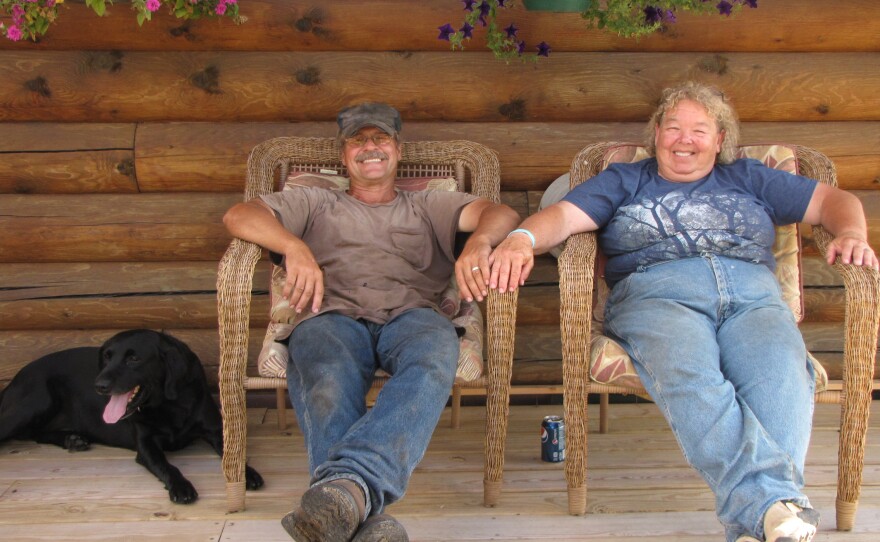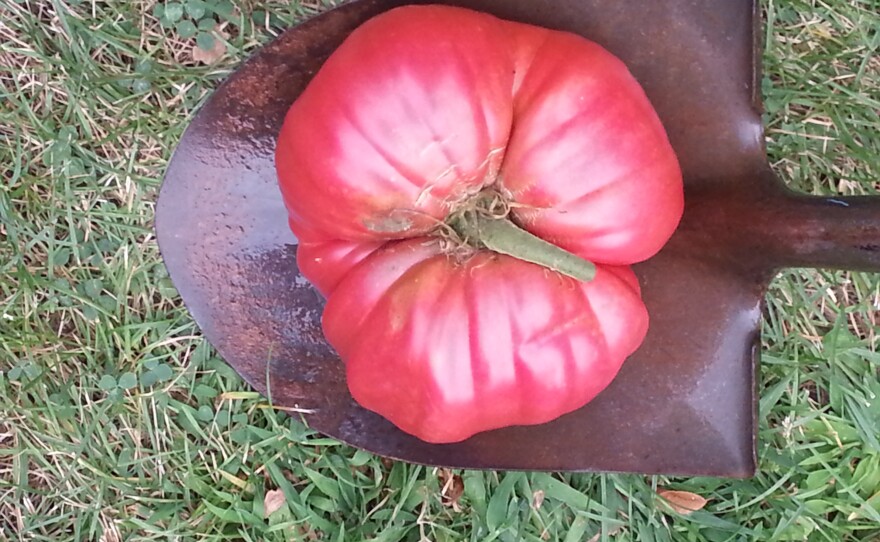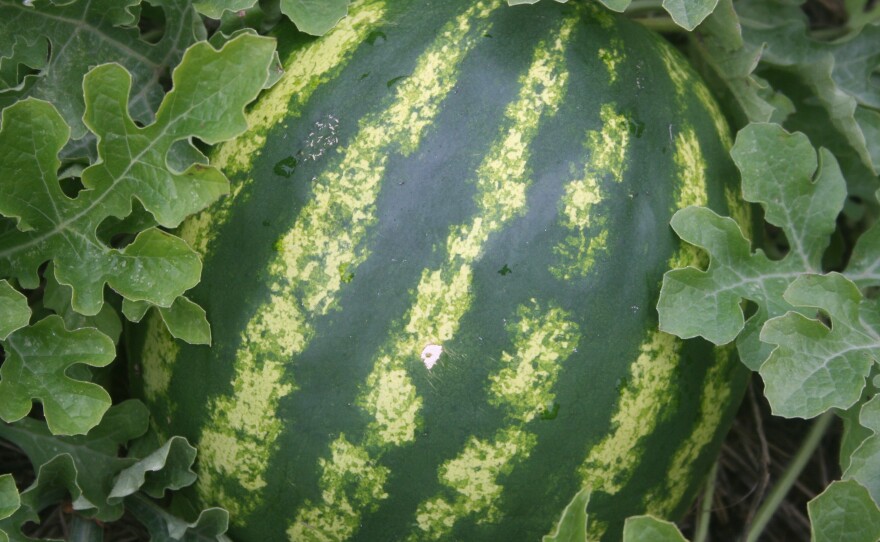Jackie Clay Atkinson is a homesteader, writer, and blogger from Angora MN.She writes for Backwoods Home Magazine. She and her husband Will also grow and sell heirloom and open pollinated seeds through their seed catalog, Seed Treasures.
Jackie talked to us on the Wednesday Morning Show.
Maggie Montgomery (MM): Tell us about your place in Angora.
Jackie Clay Atkinson (JCA): Well, let's see…our driveway’s a mile and a half long through the woods. And when you finally get to the end, we've got a log house that we've built in here. We've got 200 acres. My husband and I have both been longtime gardeners. We started gardening when we were kids, and in our late 60s and 70s, we're still gardening.
MM: This place that you have, you've called it a homestead. What do you mean by that term homesteading?
JCA: In the old days the government would give people free land in order to encourage them to develop and farm land. Now that's all changed; you buy your own homestead. But to us, modern homesteading just means that you decided to travel a more self-reliant path than the norm today. We raise most of our own food. We heat our house with the wood that we've cut out of the woods. And most of that wood is just dead or down trees. I can pretty much anything. My husband laughs and says that if it moves I’ll can it up and put it in the pantry. And if it doesn't move, I might shoot it and then can it!
MM: What inspired you and Will to take that direction in your life?
JCA: It just seemed like the right thing to do. Both of us are independent-minded people. I can remember when I was something like three years old saying, ‘I want to do it myself, Mom.’ I pretty much wanted to do it myself my whole life, and Will is kind of that way, too. You know, he can fix any machinery. He can build anything. We've cleared land for gardens. We've cleared land for pasture. We raise our own beef. We sell a little bit of beef to help pay for the feed, the expenses. So it just feels good.
MM: I know there's a story behind how you started your catalog, Seed Treasures, and it has to do with a certain squash. Will you tell it to us?
JCA: Well, I think it's the only business in the world that ever was started by a squash! The norm when you start a business is to have a business plan and then go about developing your education and formulating your plan. With us, twenty-five years ago, I bought some seeds for a very rare squash, called Hopi Pale Gray. And that squash was known for storing for a really long time - up to two years - and being one of the best tasting squash going. But unfortunately, only the Hopi people in Arizona still raised it. So I got those seeds and I loved the squash. And unfortunately, way back then, I wasn't saving seed as much as I do now. I went to buy another pack of seeds, and unfortunately the company had burned to the ground, including all of the seed. So I searched and searched. Finally, I found it in Seed Dreams, a tiny little seed saving company in Port Townsend, Washington. They had seeds. So I bought a pack of seeds and I've been saving them ever since. And that squash - because I love it, I blogged about it - and nobody else in the country had seeds to sell. So I was giving seeds away and trying to encourage people to grow it, save seeds, so that squash did not go extinct. And the last year I did that, we gave out 250 packs of seeds and just couldn't afford to do it anymore. You know, you buy the dollar padded envelope, you pay the dollar to ship the seeds. We can't do that. We're not rich people.
So through the blog and through my articles and everything, people would say, well, what other kinds of seeds do you have? We've always loved the old heirloom seeds. They figure, worldwide, five hundred varieties of these old family heirloom seeds that might have been around for 6, 7, 8 generations are going extinct every single day. And we thought that was just horrible. Grandma dies and the kids didn't really care to garden, so her house was cleaned out and those wonderful seeds were thrown on the garbage. That was the end of that variety. So every seed has a story.
MM: Tell us a little bit about the catalog. What is that catalog like? I know you've been working on getting it out lately.
JCA: Well, in that catalog, there's probably over 100 varieties of tomatoes from all over the world. You know, some are family heirlooms from the southern United States, from the desert of New Mexico, from Siberia, from Germany, Italy. And we have so much fun with these things that it's hard to condense it all down into a tiny little description that we can afford to put in a catalog. So there's squash, there's watermelons. And everything in that catalog we have grown here on our place and found it to be good tasting, very hardy. I mean, we're in northern Minnesota, after all…and productive because I'm a canner. We live a self-reliant lifestyle. I cannot afford to have crops that don't produce a lot of food!
MM: So most of these seeds or all of these seeds are things that you have tested on your homestead.
JCA: Yes, they are.
MM: How do you decide what varieties to add to your catalog?
JCA: That's hard because it's like saying which are your favorite grandchildren. You know, you can't just pick and choose. But we try really hard every year. We try a few new things. And like I said, if they don't taste good, if they're not productive, if you've got a fight to get them to grow here, they don't make the catalog because we don't grow them again. If the tomato doesn't taste good…we're really picky...if it doesn't taste good, I just grind it up and make tomato sauce out of it and don't save the seeds. They just go away.
MM: So is it harder to grow and gather some seeds more than others?
JCA: Well, it isn't so much harder to grow. There is an issue with cross-pollination and some seeds…corn is wind pollinated and that pollen can blow up to a mile away. Luckily, we're in a middle of the woods, so we don't have any neighbors growing corn that would cross-pollinate. But we've got to be very careful about isolating some of the crops so that wandering bees don't cross-pollinate our squash; the wind doesn't blow pollen from one variety of corn to another. So that's our biggest issue. But we've got six big gardens and a bunch of little patches here or there. We have to fence six feet high to keep the deer out but it’s worth it. We're in the middle of the woods and we've got lots of deer.
MM: What about biennial crops that just bear seeds every other year?
JCA: Right. Well, we have grown them and brought them in the house. We've got an unheated basement. I put them in five gallon buckets, put them in the basement over winter, and then you'll probably get maybe two out of five that'll make it. The other three will rot. But those ones, those two crop plants that will make it can go back in the garden and go ahead and make seeds. And it's really interesting to see a cabbage; you think of a cabbage as this round green thing. Well, when they go to make a seeds - excuse me, seed stock - the cabbage head splits open, this big stalk comes out of it and looks like something from a horror movie. But we have friends out west in Washington state that grow most of our biennial crops because it's so hard here to do it. We can do it, but it's just not feasible.
MM: Do they over winter there then, for the second year?
JCA: Yeah. They can overwinter outside.
MM: So it sounds like things that we think are bolting are exactly what you want them to do to produce seeds.
JCA: They're trying to do what nature made them do. But the thing we've learned…like onions, you'll plant a couple rows of onions and you'll get a couple little bolts. You don't want to save seeds from them because it's basically encouraging that genetic makeup that makes them bolt early on. You don't want onions that bolt early because then the bulb doesn't form well.
MM: So there's a lot to this, when you're saving seeds. With tomatoes, how do you save the seeds? From the earliest fruit? How do you how do you decide how to select for different traits in things like that?
JCA: Well, some of our tomatoes are extra early. So we pick the very best flavored early tomatoes and we save seeds from those. And some of them are not so early, but they grow very large and have wonderful flavor. So we pick the ones that are the nicest shaped fruits; the prettiest. Not the latest ones because you don't want to encourage that genetic trait; the latest tomato on the vine. So it all depends on what you're selecting for. With paste tomatoes we try to choose tomatoes that are early to mid-season, nice shape, very meaty. And, you know, save he seeds mostly from those fruits.
MM: Jackie, you don't have online ordering, but you do have a website. How do people get a copy of your catalog?
JCA: All they have to do is e-mail me and I would be happy to send the catalog. Our website is just seedtreasures.com.
MM: As if you don't have enough to do, you have written some fiction, and a lot of people follow your homesteading through your blogand your column for Backwoods Home Magazine. And you have an Ask Jackie column, I understand, right?
JCA: Yes. This is like asking, you know, Dear Abby, but I don't give any romantic advice.
MM: What kind of things do people ask you?
JCA: It's a great, huge variety. It'll be whether or not you can water bath green beans, which you cannot do. To: ‘I'm 72 years old, am my too old to homestead?’ ‘My goat is having her hair fall out. What's wrong with her?’ ‘I'm a young person and want to learn to farm. How do I do that?’ It just is a huge variety of challenges. Sometimes I think they're trying to ‘stump Jackie,’ and they do once in a while.
MM: Some of those are really big questions.
JCA: Yes, it is. I've got a limited space in the magazine to answer these questions, so I have to learn to be a little concise about it.
MM: What is the most fun thing for you about writing about homesteading?
JCA: Writing about home setting is going back on my own memories. Because everything I write about is stuff we do or have done. So a lot of this stuff is like, oh, yeah, I did that way back in ‘whatchacallit.’ You know, if it's remembering all that family time and growing time, the fun things, the disasters.
MM: So what are you working on now for an article for the magazine?
JCA: I'm doing an article on how much you actually need to plant to make it through a whole year like the old timers did. Say you can't get to the store for some reason…how much food do you really need to plant?
MM: I'm thinking it's a lot.
JCA: It is. A long time ago, we lived up way up in the mountains in Montana, about a thousand feet above the continental divide. And we actually were snowed in six months of the year. It was amazing to me to learn how much you actually needed in order not to just survive, but thrive. You know, we went through 300 pounds of flour. You think, my God, how could you do that? Well, you know, in the morning you have toast or pancakes or whatever, and at lunch, maybe a chicken noodle soup. Well, you have to make the noodles to put in the chicken soup…
MM: And you had to make the bread for the toast.
JCA: Well, sure. It was an eye-opener to me to learn how much we actually needed to store up if you couldn't run to the store. I mean, we don't run to the store every day. Maybe once a week or whatever, and my shopping cart is not full. But it was a real eye-opener to see how much food a small family - there were just three of us then - how much we actually ate.
You know, I speak at a lot of self-reliance expos and preparedness shows. And people will come up to me and say, ‘Well, I've got a five gallon bucket of rice and I got a five gallon bucket of beans and we're all set for the zombie apocalypse.’ And I just looked at them and laugh in their face. I'm not expecting any zombies to come crawling up to my door. And that bucket of rice and beans would get awful stale, eating that three meals a day.
MM: That is Jackie Clay Atkinson from Angora. She’s a homesteader and writer. To get on the mailing list for the Seed Treasures catalog, go toseed treasurers dot com. Jackie, thank you for talking with us this morning.
JCA: It’s been fun, Maggie.








